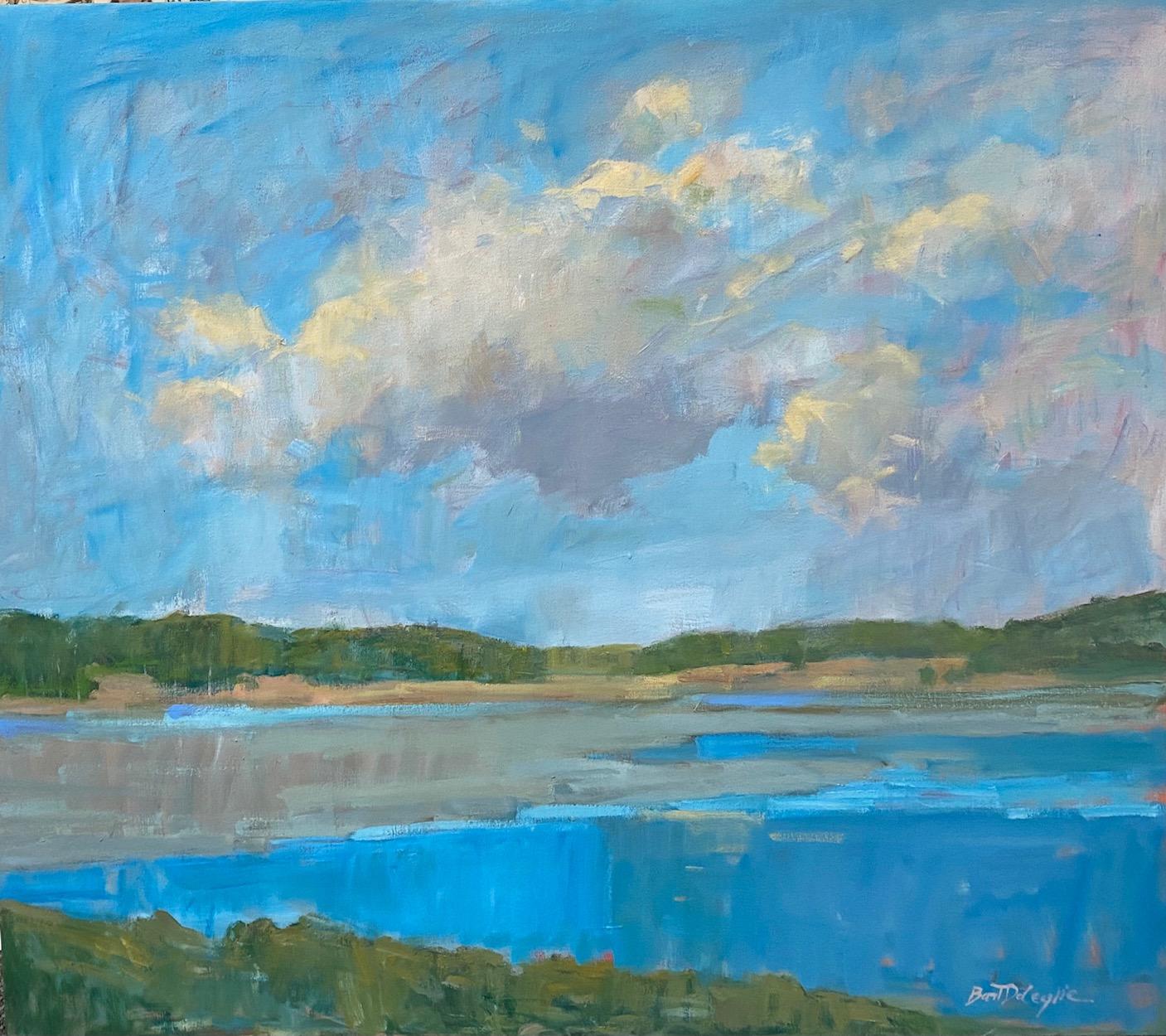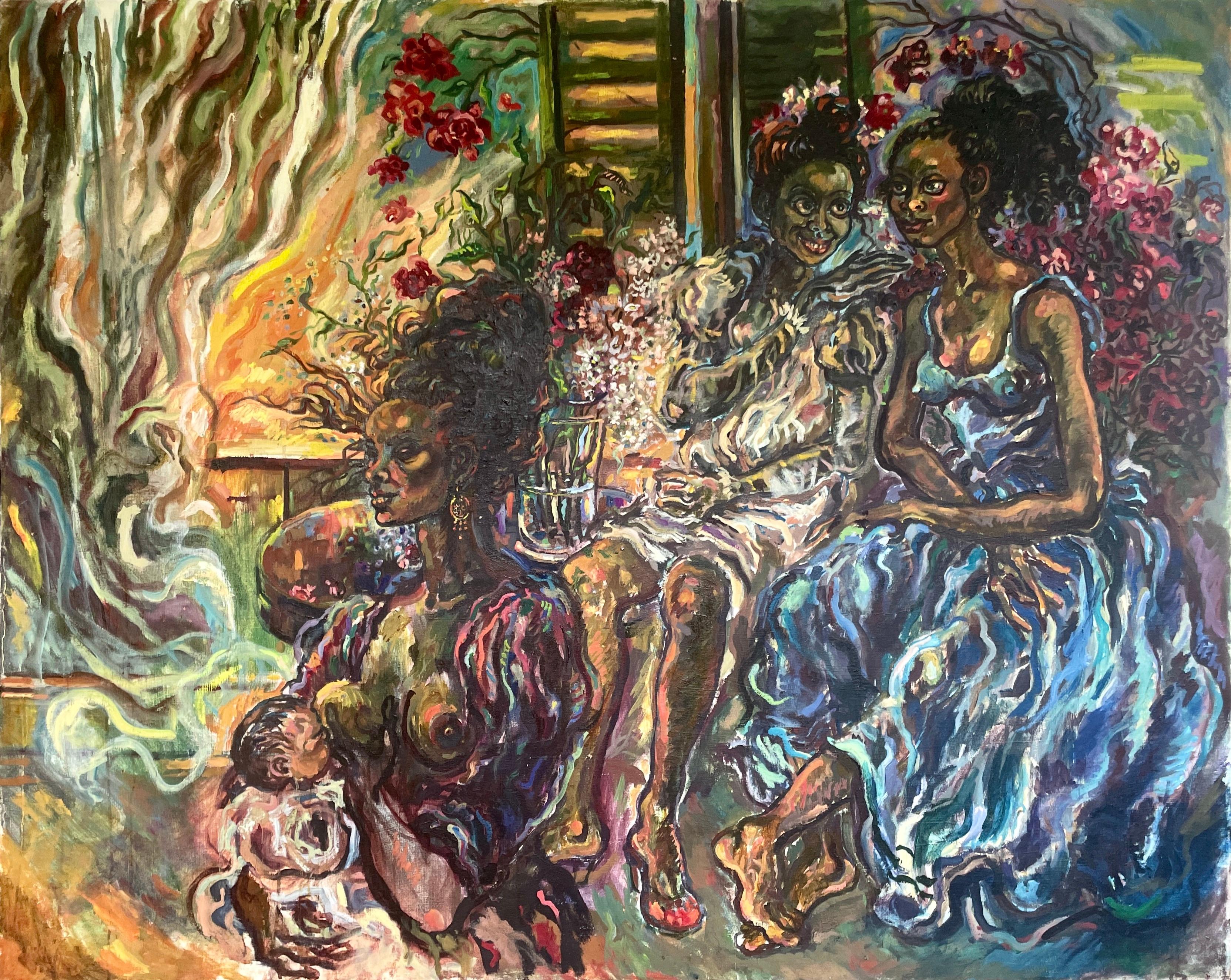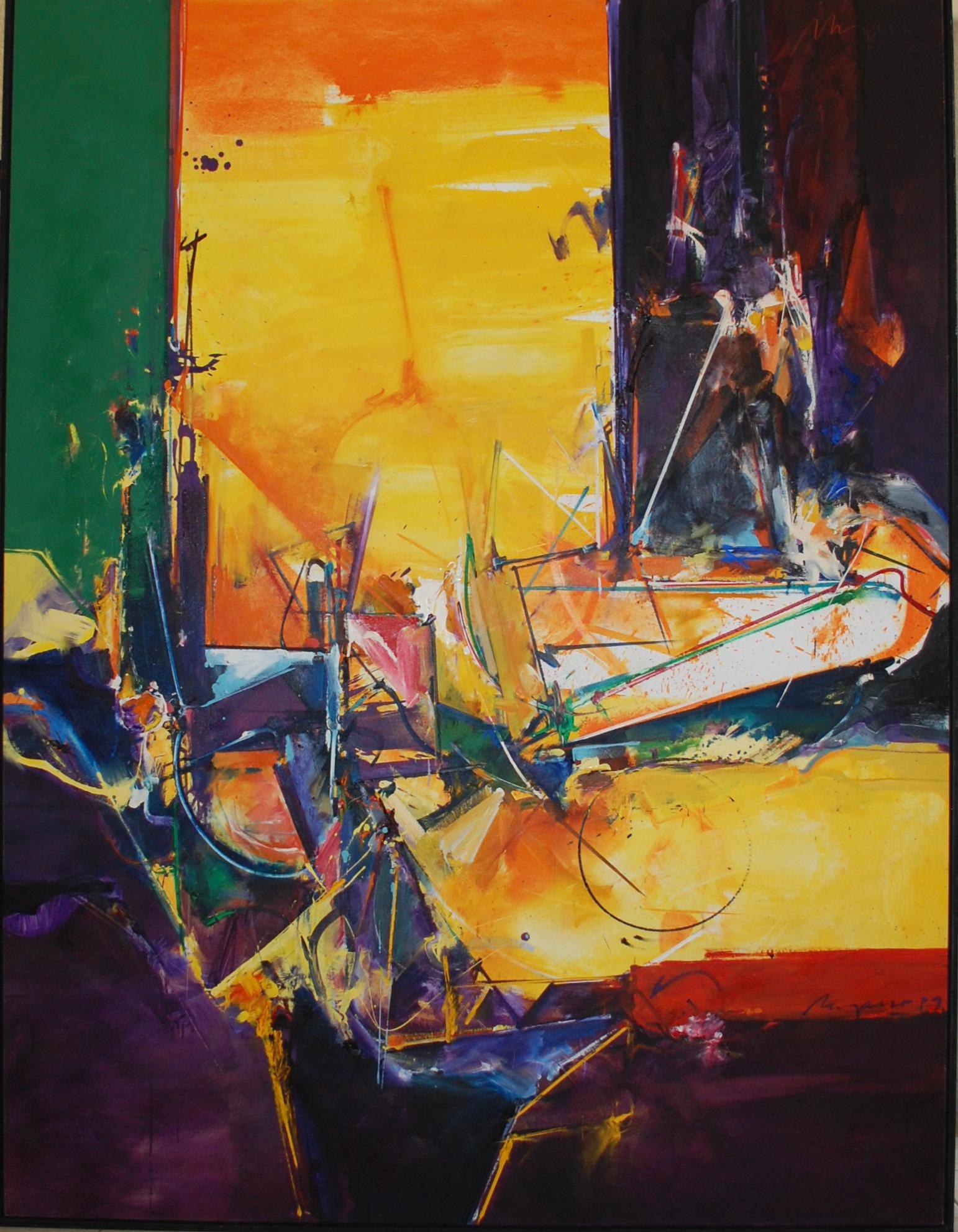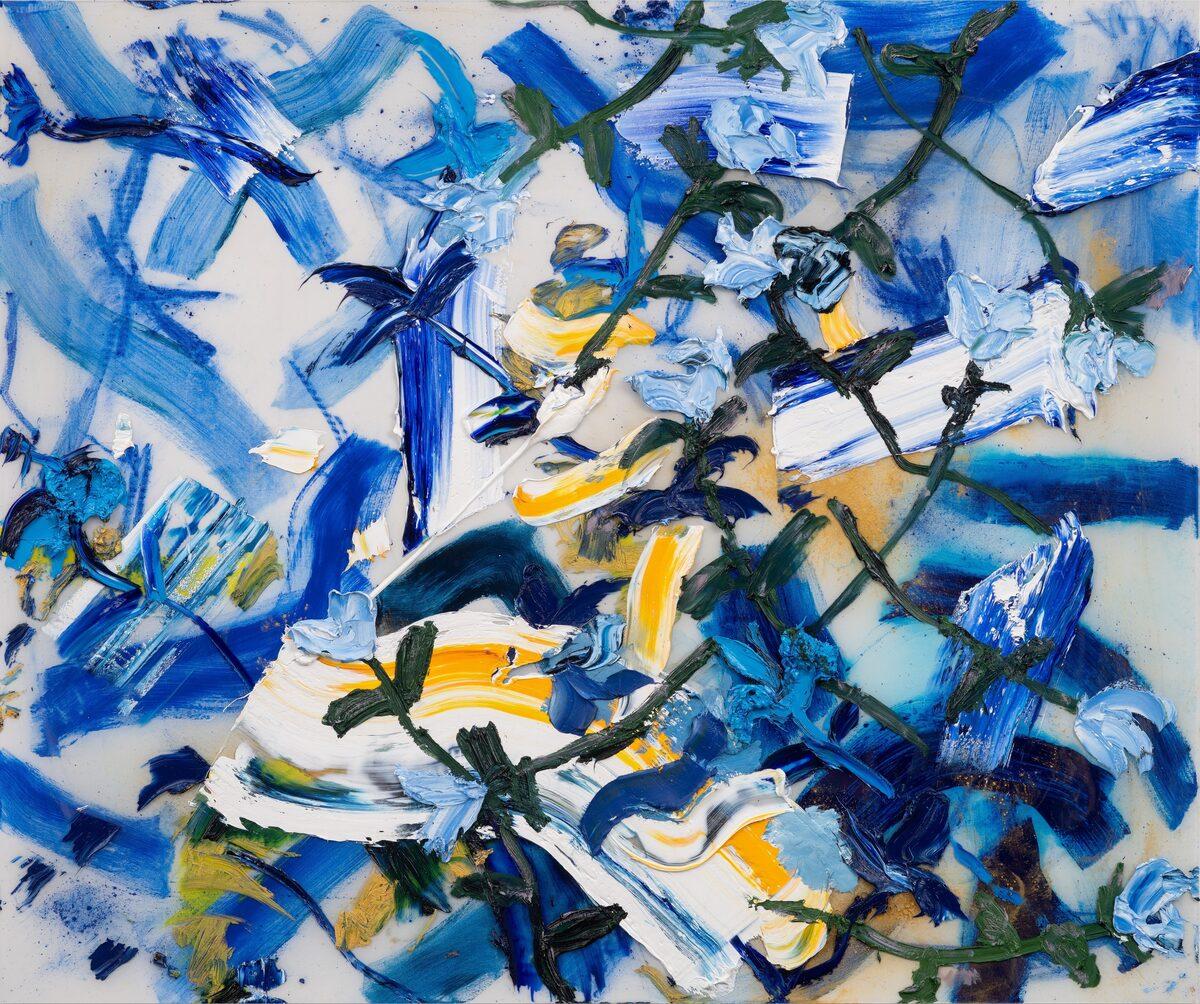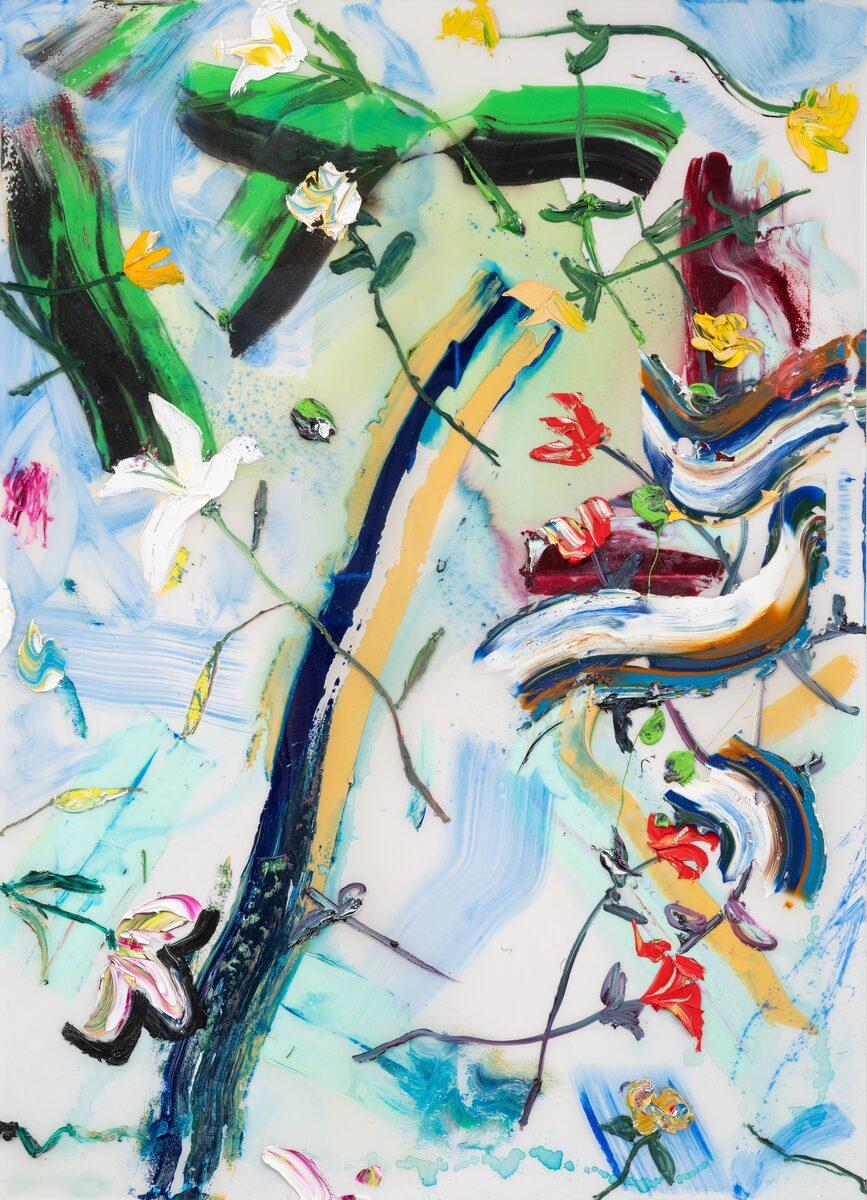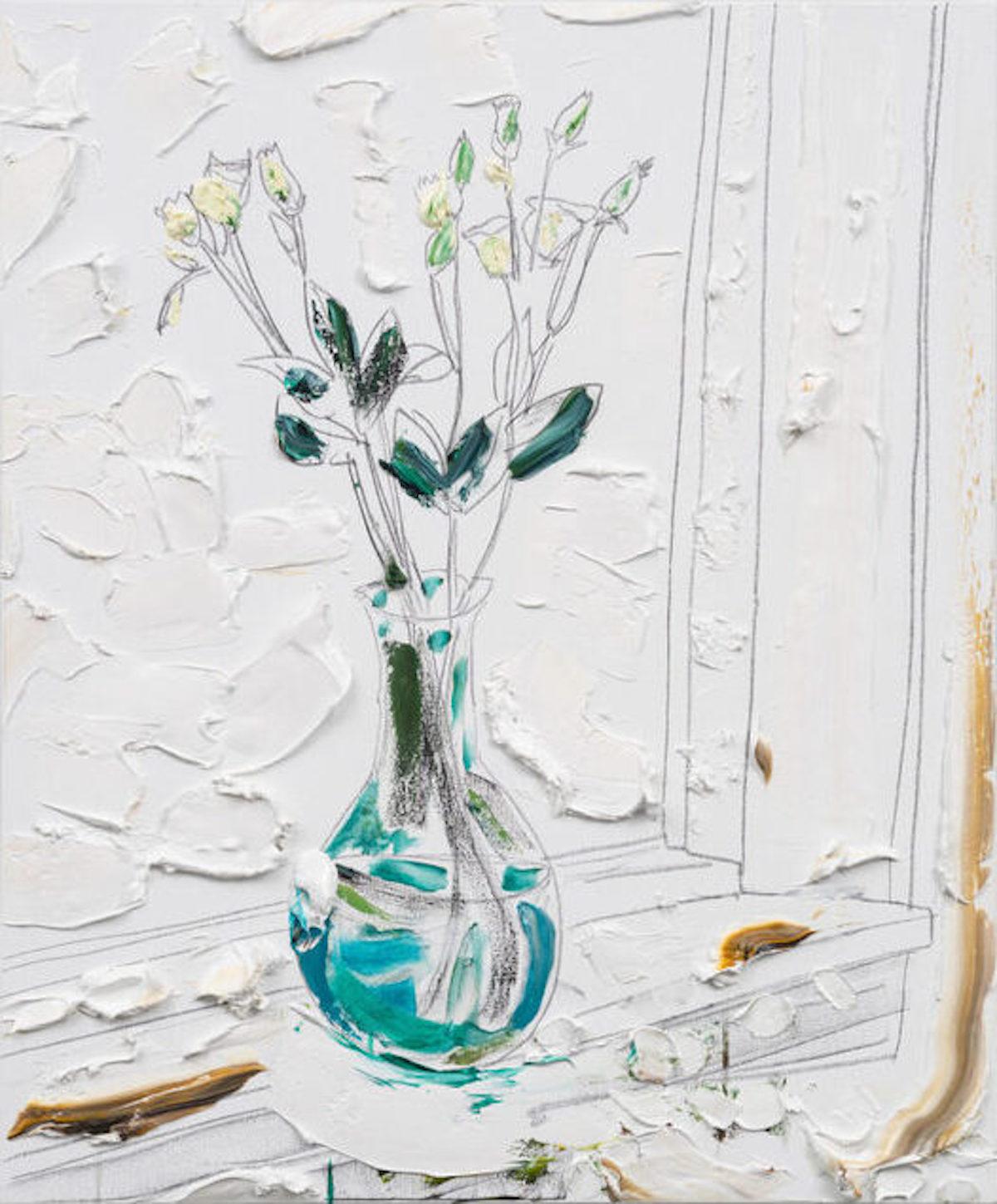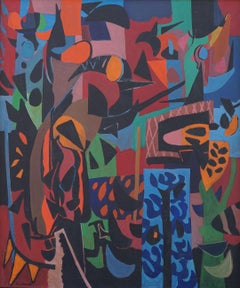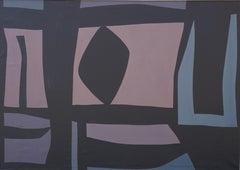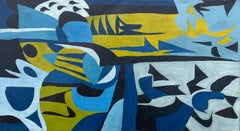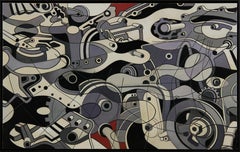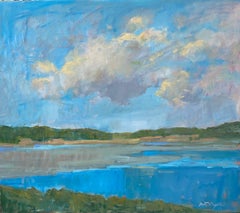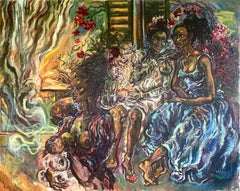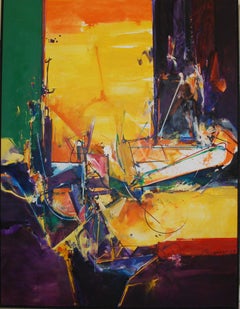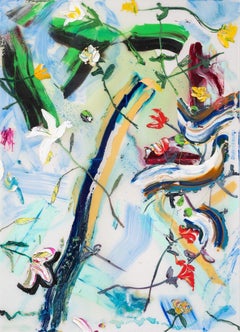Items Similar to M-62, Mid-Century Abstract Expressionist Painting, 20th Century New York Artist
Video Loading
Want more images or videos?
Request additional images or videos from the seller
1 of 10
James JohnsonM-62, Mid-Century Abstract Expressionist Painting, 20th Century New York Artistc. 1950s
c. 1950s
About the Item
James Johnson (American, 1925-1963)
M-62, c. 1950s
Oil on canvas
46 x 46 inches
In the late 1950s, Johnson moved with his wife Marjorie and their new born son from Berkeley California to Painseville, Ohio. There, Johnson threw himself completely into Abstract Expressionism creating works that evolved directly from his earlier still-life paintings and his emotional struggle with his past. Born in 1925, his father abandoned his family when Johnson was around the age of five. He continued to have a distant and tumultuous relationship with his mother and stepfather who showed preference to his stepbrother. Johnson lied about his age in order to join the Navy and leave behind a fractured family life. At seventeen he found himself on a mine sweeper in the Mediterranean Sea during World War II. His ship had a close call after hitting a mine, however it did not detonate and the crew passed safely. The experience left an impact on him that he would continue to contemplate
throughout his life.
After the war, Johnson returned to New York City in 1949 and enrolled at the Art Students League where he studied under Reginald Marsh. While Marsh instilled a sense of Social realism into Johnson’s work, his studio was located next to that of Jackson Pollock. Soon, Johnson enrolled at the University of Illinois where he met Richard Diebenkorn. The influence Diebenkorn had on Johnson’s ideas and paintings was profound. He soon began to abstract his still life arrangements in multiple works that each became more abstract and reductive.
However, Johnson grew frustrated with his professors and their particular views on art. He left the program and moved with Marjorie to Berkeley, California in 1953. Diebenkorn would stop by during visits to the area and continue to discuss the development of Abstract Expressionist concepts. Johnson continued to work in a realist style but further explored abstraction in oils. Francis Carmody noted in an interview that there appeared to be an aspect of violence in the work. Johnson acknowledged the observation,“What I may be destroying at this particular time is something that is much more of myself than the thing that I leave is of Braque or Matisse or Picasso, but these great men exist and it’s my problem to overcome whatever influence they have in a destructive and creative manner.” Through hastily drawn lines that alluded to this sense of violence, Johnson would feel both the work and himself calm to a point in which the completed painting expressed a sense of serenity.
Johnson was well read on art theory, and particularly the writings of Hans Hoffman. He interpreted and adapted what he had read into the work he created by placing quickly executed multi-layered calligraphic structures of paint in red, blue, yellow, and olive with thick textured coats of black and grey. The complex layers of paint were covered over and reduced with the use of black paint in a similar way in which he removed objects in his still life paintings. Johnson makes use of sgraffito, scratching into the paint surface, as well as splattering paint in drips of motion finding in the experience of painting a relationship between the surface and an inner mental landscape. He spoke of his method that,“painting is an organic process which feeds on plastic memories and the excitement of an adventurous accident solidified in the final state of decision.”
After the move to Nor theast Ohio, Johnson found that proximity of Painesville to Cleveland gave him access to a variety of galleries. He soon made connections with Howard Wise, owner of the Howard Wise Gallery of Present Day Art. Unlike many other local artists, Johnson was already working fully in the style having come out of the New York School, and then being surrounded by the San Francisco Bay area Abstract Expressionists. This gave Johnson the advantage of authenticity and a sense of belonging to the movement that other artists often struggled with. Impressed by Johnson’s new paintings, Wise decided gave him a one-man show of grey monotone compositions in 1959. The Cleveland Plain Dealer art critic Paul B. Metzler wrote that the work “recalled some of the greatest Chinese pictorials,” and that they reflected the influences of de Kooning, Franz Kline, and Clyford Still.
Johnson’s reputation as a painter grew in Northeast Ohio, and soon the artist’s abstractions became looser and more vibrant with the limited palette consisting of large sections in black, white, and red. However, an unrest stirred within him. In 1962, he abruptly left his wife and children to return to New York City. After the move, Johnson increasingly became less involved with his work. He began to feel less satisfaction in painting, and his output slowed as he started thinking and talking about his children and his own father’s abandonment more often. He started working on paintings that were void of all color. Large black masses crowded out the white of the canvas barely able to peek through. Collectors of his work from Painesville traveled to New York for a studio visit, but did not respond to the new pieces. Shortly after, Johnson ceased painting altogether.
In November of 1963, Johnson began to work on new paintings that were smaller and alluded to a continuous movement off the edges of the canvas. On the brink of an artistic breakthrough, Johnson’s life was cut short on December 9th at the age of 37 in a tragic accident while riding his motorcycle — not even a full month after actualizing the new work.
- Creator:James Johnson (1925 - 1963, American)
- Creation Year:c. 1950s
- Dimensions:Height: 46 in (116.84 cm)Width: 46 in (116.84 cm)
- Medium:
- Movement & Style:
- Period:
- Condition:
- Gallery Location:Beachwood, OH
- Reference Number:1stDibs: LU1768215492292
About the Seller
5.0
Gold Seller
Premium sellers maintaining a 4.3+ rating and 24-hour response times
Established in 1975
1stDibs seller since 2022
23 sales on 1stDibs
Typical response time: 4 hours
- ShippingRetrieving quote...Shipping from: Beachwood, OH
- Return Policy
Authenticity Guarantee
In the unlikely event there’s an issue with an item’s authenticity, contact us within 1 year for a full refund. DetailsMoney-Back Guarantee
If your item is not as described, is damaged in transit, or does not arrive, contact us within 7 days for a full refund. Details24-Hour Cancellation
You have a 24-hour grace period in which to reconsider your purchase, with no questions asked.Vetted Professional Sellers
Our world-class sellers must adhere to strict standards for service and quality, maintaining the integrity of our listings.Price-Match Guarantee
If you find that a seller listed the same item for a lower price elsewhere, we’ll match it.Trusted Global Delivery
Our best-in-class carrier network provides specialized shipping options worldwide, including custom delivery.More From This Seller
View AllMagic Garden, vibrant mid-century abstract expressionist colorful geometric work
By Richard Andres
Located in Beachwood, OH
Richard Andres (American, 1927-2013)
Magic Garden, c. 1962
oil on canvas
signed lower left, signed and titled verso
50 x 42 inches
Richard Andres was born in Buffalo, New York in 19...
Category
1960s Abstract Expressionist Abstract Paintings
Materials
Oil
Blue Wall, mid-century abstract expressionist, geometric blue, black & pink work
By Richard Andres
Located in Beachwood, OH
Richard Andres (American, 1927-2013)
Blue Wall, c. 1959
oil on canvas
signed and titled verso
42 x 60 inches
Richard Andres was born in Buffalo, New York in 1927. A graduate of the Cleveland Institute of Art in 1950, he was immediately drafted and served for two years in the army as a mural painter. He received his Master of Arts from Kent State in 1961. A frequent exhibitor at galleries and museums and winner of multiple May Show prizes, Andres taught art in the Cleveland Public Schools for 28 years, as well as teaching the University of Buffalo, the Cleveland Institute of Art and the Western Reserve University.
Very little in Richard Andres’ childhood would have predicted his love of classical music, mid-century-modern architecture and certainly not his lifelong passion for art and in particular abstract art. Richard’s father, Raymond, had no more than a third-grade education, and his mother, Clara, was one of thirteen children – only three of whom lived into adulthood and none of whom attended high school.
They lived, when Richard was a boy, in a dingy area of Buffalo, NY in a walk-up apartment situated above a tavern. Raymond and Clara supplemented the income from their factory jobs in the bar downstairs with Raymond playing ragtime on the piano and Clara serving drinks. This often left Richard and his two older brothers at home alone to fend for themselves. The two older boys, Raymond and Russell, were - unlike Richard- rather rough and tumble and entertained themselves with stickball, boxing and the like. Richard, on the other hand, from a very young age liked to draw, or better yet even, to paint with the small set of watercolors he received for Christmas one year. Paper, however, at the height of the depression, was hard to come by. Luckily, Clara used paper doilies as decoration for the apartment and Richard would contentedly paint and then cut up doilies, gluing the pieces together to create collages.
At eight-years-old, he discovered the Albright-Knox Museum (then known as the Albright Art Gallery) and spent several hours a week there studying the paintings. He was particularly fond of Charles Burchfield‘s landscapes, enamored with their ‘messiness’ and thinking that they somehow captured more ‘feeling’ than works he was previously familiar with. For his tenth Christmas, he asked for and received a ‘how-to’ paint book by Elliot O’Hare. Through this self-teaching, he assembled the portfolio needed for acceptance to Buffalo Technical High School where he studied Advertising Arts. In his Junior year, he was encouraged to enter a watercolor painting, “Two Barns,” in the national 1944-45 Ingersoll Art Award Contest and was one of twelve grand prize winners – each one winning one hundred dollars. More importantly the painting was exhibited at the Carnegie Institute Galleries, which resulted in his winning a national scholarship to the Cleveland School of Art (The Cleveland Art Institute).
He flourished at the art school under the tutelage of faculty members such as Carl Gaertner, as well as that of visiting artists such as William Sommer and Henry George Keller. He would say in later years that Gaertner, in particular, influenced his attitude toward life as well as art. “Gaertner,” Andres said, “believed that there was no need to be a ‘tortured artist’, that an artist should rather enjoy beauty, family, and life in general.” Free to spend his days as he chose, he wandered the Cleveland Art Museum for most of the hours he was not attending classes or painting; the remaining time was spent drinking coffee at a local hangout with art school friends – which is where he met fellow Henry Keller scholarship winner, Avis Johnson. Richard was immediately smitten with Avis, but being rather shy, it took him the entire summer of 1948 to build up his courage to ask her out. Over that summer he ‘thought about Avis’ and worked in a diner to save money. He also used the hundred-dollar prize money won in High School to visit the first Max Beckmann retrospective in the United States at the City Art Museum in St. Louis. Over a half century later he spoke of that exhibit with a reverence usually reserved for spiritual matters, “I walked in and it was like nothing I had ever seen before... the color...It just glowed.”
Returning to campus in the Fall, the first thing he did was go to the coffee shop in hopes of finding Avis. He did, and she, upon seeing him, realized that she was also smitten with him. They quickly became known as ‘the couple’ on campus, and a year later, with Richard being drafted for the Korean war, they were quickly married by a Justice of the Peace, celebrating after with family at Avis’s Cleveland home. As a gift, faculty member John Paul Miller designed and made the simple gold wedding ring Avis wore for their 65 years of marriage. During those 65 years neither wavered in their mutual love, nor in the respect they shared for one another’s art.
The couple lived in a converted chicken coop in Missouri while Richard was in boot camp. At the camp, he would volunteer for any job offered and one of those jobs ended up being painting road signs. His commander noticed how quickly and neatly he worked and gave him more painting work to do - eventually recommending him for a position painting murals for Army offices in Panama. Until her dying day, Avis remained angry that “The army got to keep those fabulous murals and they probably didn’t even know how wonderful they were.” In Panama, their first son, Mark, was born. After Richard’s discharge in 1953, they moved back to the Cleveland area and used the GI bill to attend Kent State gaining his BA in education. The small family then moved briefly to Buffalo, where Richard taught at the Albright Art School and the University of Buffalo – and their second son, Peter, was born. Richard had exhibited work in the Cleveland May Show and the Butler Art Museum during his art school years, and during the years in Buffalo, his work was exhibited at the gallery he had so loved as a child, the Albright Art Gallery.
In 1956, the family moved back to the Cleveland area and Richard began teaching art at Lincoln West High School during the day while working toward his MA in art at Kent State in the evenings. Avis and Richard, with the help of an architect, designed their first home - a saltbox style house in Hudson, Ohio, and in 1958, their third son, Max (after Max Beckmann) was born. Richard enjoyed the consistency of teaching high school as well as the time it gave him to paint on the weekends and during the summer months. In 1961, he received his MA and his daughter, Claire, was born. With a fourth child, the house was much too small, and Avis and Richard began designing their second home. An admirer of MCM architecture, Richard’s favorite example of the style was the Farnsworth house – he often spoke of how the concepts behind this architectural style, particularly that of Mies van der Rohe, influenced his painting.
Andres described himself as a 1950’s...
Category
1950s Abstract Expressionist Abstract Paintings
Materials
Oil
Abstract expressionist blue, black & green mid-century geometric painting
By Richard Andres
Located in Beachwood, OH
Richard Andres (American, 1927-2013)
Untitled, c. 1949
oil on canvas
18 x 32 inches
Richard Andres was born in Buffalo, New York in 1927. A graduate of the Cleveland Institute of Art in 1950, he was immediately drafted and served for two years in the army as a mural painter. He received his Master of Arts from Kent State in 1961. A frequent exhibitor at galleries and museums and winner of multiple May Show prizes, Andres taught art in the Cleveland Public Schools for 28 years, as well as teaching the University of Buffalo, the Cleveland Institute of Art and the Western Reserve University.
Very little in Richard Andres’ childhood would have predicted his love of classical music, mid-century-modern architecture and certainly not his lifelong passion for art and in particular abstract art. Richard’s father, Raymond, had no more than a third-grade education, and his mother, Clara, was one of thirteen children – only three of whom lived into adulthood and none of whom attended high school.
They lived, when Richard was a boy, in a dingy area of Buffalo, NY in a walk-up apartment situated above a tavern. Raymond and Clara supplemented the income from their factory jobs in the bar downstairs with Raymond playing ragtime on the piano and Clara serving drinks. This often left Richard and his two older brothers at home alone to fend for themselves. The two older boys, Raymond and Russell, were - unlike Richard- rather rough and tumble and entertained themselves with stickball, boxing and the like. Richard, on the other hand, from a very young age liked to draw, or better yet even, to paint with the small set of watercolors he received for Christmas one year. Paper, however, at the height of the depression, was hard to come by. Luckily, Clara used paper doilies as decoration for the apartment and Richard would contentedly paint and then cut up doilies, gluing the pieces together to create collages.
At eight-years-old, he discovered the Albright-Knox Museum (then known as the Albright Art Gallery) and spent several hours a week there studying the paintings. He was particularly fond of Charles Burchfield‘s landscapes, enamored with their ‘messiness’ and thinking that they somehow captured more ‘feeling’ than works he was previously familiar with. For his tenth Christmas, he asked for and received a ‘how-to’ paint book by Elliot O’Hare. Through this self-teaching, he assembled the portfolio needed for acceptance to Buffalo Technical High School where he studied Advertising Arts. In his Junior year, he was encouraged to enter a watercolor painting, “Two Barns,” in the national 1944-45 Ingersoll Art Award Contest and was one of twelve grand prize winners – each one winning one hundred dollars. More importantly the painting was exhibited at the Carnegie Institute Galleries, which resulted in his winning a national scholarship to the Cleveland School of Art (The Cleveland Art Institute).
He flourished at the art school under the tutelage of faculty members such as Carl Gaertner, as well as that of visiting artists such as William Sommer and Henry George Keller. He would say in later years that Gaertner, in particular, influenced his attitude toward life as well as art. “Gaertner,” Andres said, “believed that there was no need to be a ‘tortured artist’, that an artist should rather enjoy beauty, family, and life in general.” Free to spend his days as he chose, he wandered the Cleveland Art Museum for most of the hours he was not attending classes or painting; the remaining time was spent drinking coffee at a local hangout with art school friends – which is where he met fellow Henry Keller scholarship winner, Avis Johnson. Richard was immediately smitten with Avis, but being rather shy, it took him the entire summer of 1948 to build up his courage to ask her out. Over that summer he ‘thought about Avis’ and worked in a diner to save money. He also used the hundred-dollar prize money won in High School to visit the first Max Beckmann retrospective in the United States at the City Art Museum in St. Louis. Over a half century later he spoke of that exhibit with a reverence usually reserved for spiritual matters, “I walked in and it was like nothing I had ever seen before... the color...It just glowed.”
Returning to campus in the Fall, the first thing he did was go to the coffee shop in hopes of finding Avis. He did, and she, upon seeing him, realized that she was also smitten with him. They quickly became known as ‘the couple’ on campus, and a year later, with Richard being drafted for the Korean war, they were quickly married by a Justice of the Peace, celebrating after with family at Avis’s Cleveland home. As a gift, faculty member John Paul Miller designed and made the simple gold wedding ring Avis wore for their 65 years of marriage. During those 65 years neither wavered in their mutual love, nor in the respect they shared for one another’s art.
The couple lived in a converted chicken coop in Missouri while Richard was in boot camp. At the camp, he would volunteer for any job offered and one of those jobs ended up being painting road signs. His commander noticed how quickly and neatly he worked and gave him more painting work to do - eventually recommending him for a position painting murals for Army offices in Panama. Until her dying day, Avis remained angry that “The army got to keep those fabulous murals and they probably didn’t even know how wonderful they were.” In Panama, their first son, Mark, was born. After Richard’s discharge in 1953, they moved back to the Cleveland area and used the GI bill to attend Kent State gaining his BA in education. The small family then moved briefly to Buffalo, where Richard taught at the Albright Art School and the University of Buffalo – and their second son, Peter, was born. Richard had exhibited work in the Cleveland May Show and the Butler Art Museum during his art school years, and during the years in Buffalo, his work was exhibited at the gallery he had so loved as a child, the Albright Art Gallery.
In 1956, the family moved back to the Cleveland area and Richard began teaching art at Lincoln West High School during the day while working toward his MA in art at Kent State in the evenings. Avis and Richard, with the help of an architect, designed their first home - a saltbox style house in Hudson, Ohio, and in 1958, their third son, Max (after Max Beckmann) was born. Richard enjoyed the consistency of teaching high school as well as the time it gave him to paint on the weekends and during the summer months. In 1961, he received his MA and his daughter, Claire, was born. With a fourth child, the house was much too small, and Avis and Richard began designing their second home. An admirer of MCM architecture, Richard’s favorite example of the style was the Farnsworth house – he often spoke of how the concepts behind this architectural style, particularly that of Mies van der Rohe, influenced his painting.
Andres described himself as a 1950’s...
Category
1940s Abstract Expressionist Abstract Paintings
Materials
Oil
Figural Abstract Painting w/ Gears of an Engine, Ohio Artist
Located in Beachwood, OH
James Massena March (American, 1953-2021)
Untitled
Oil on canvas
30 x 48 inches
"My paintings are about space, form and energy. I generally start painting without preconceived notio...
Category
Late 20th Century Abstract Expressionist Abstract Paintings
Materials
Oil
Abstract expressionist, white and yellow mid-century modern geometric painting
By Richard Andres
Located in Beachwood, OH
Richard Andres (American, 1927-2013)
White & Yellow, c. 1953
oil on canvas
signed lower right, signed and titled verso
30 x 20 inches
Richard Andres was born in Buffalo, New York in 1927. A graduate of the Cleveland Institute of Art in 1950, he was immediately drafted and served for two years in the army as a mural painter. He received his Master of Arts from Kent State in 1961. A frequent exhibitor at galleries and museums and winner of multiple May Show prizes, Andres taught art in the Cleveland Public Schools for 28 years, as well as teaching the University of Buffalo, the Cleveland Institute of Art and the Western Reserve University.
Very little in Richard Andres’ childhood would have predicted his love of classical music, mid-century-modern architecture and certainly not his lifelong passion for art and in particular abstract art. Richard’s father, Raymond, had no more than a third-grade education, and his mother, Clara, was one of thirteen children – only three of whom lived into adulthood and none of whom attended high school.
They lived, when Richard was a boy, in a dingy area of Buffalo, NY in a walk-up apartment situated above a tavern. Raymond and Clara supplemented the income from their factory jobs in the bar downstairs with Raymond playing ragtime on the piano and Clara serving drinks. This often left Richard and his two older brothers at home alone to fend for themselves. The two older boys, Raymond and Russell, were - unlike Richard- rather rough and tumble and entertained themselves with stickball, boxing and the like. Richard, on the other hand, from a very young age liked to draw, or better yet even, to paint with the small set of watercolors he received for Christmas one year. Paper, however, at the height of the depression, was hard to come by. Luckily, Clara used paper doilies as decoration for the apartment and Richard would contentedly paint and then cut up doilies, gluing the pieces together to create collages.
At eight-years-old, he discovered the Albright-Knox Museum (then known as the Albright Art Gallery) and spent several hours a week there studying the paintings. He was particularly fond of Charles Burchfield‘s landscapes, enamored with their ‘messiness’ and thinking that they somehow captured more ‘feeling’ than works he was previously familiar with. For his tenth Christmas, he asked for and received a ‘how-to’ paint book by Elliot O’Hare. Through this self-teaching, he assembled the portfolio needed for acceptance to Buffalo Technical High School where he studied Advertising Arts. In his Junior year, he was encouraged to enter a watercolor painting, “Two Barns,” in the national 1944-45 Ingersoll Art Award Contest and was one of twelve grand prize winners – each one winning one hundred dollars. More importantly the painting was exhibited at the Carnegie Institute Galleries, which resulted in his winning a national scholarship to the Cleveland School of Art (The Cleveland Art Institute).
He flourished at the art school under the tutelage of faculty members such as Carl Gaertner, as well as that of visiting artists such as William Sommer and Henry George Keller. He would say in later years that Gaertner, in particular, influenced his attitude toward life as well as art. “Gaertner,” Andres said, “believed that there was no need to be a ‘tortured artist’, that an artist should rather enjoy beauty, family, and life in general.” Free to spend his days as he chose, he wandered the Cleveland Art Museum for most of the hours he was not attending classes or painting; the remaining time was spent drinking coffee at a local hangout with art school friends – which is where he met fellow Henry Keller scholarship winner, Avis Johnson. Richard was immediately smitten with Avis, but being rather shy, it took him the entire summer of 1948 to build up his courage to ask her out. Over that summer he ‘thought about Avis’ and worked in a diner to save money. He also used the hundred-dollar prize money won in High School to visit the first Max Beckmann retrospective in the United States at the City Art Museum in St. Louis. Over a half century later he spoke of that exhibit with a reverence usually reserved for spiritual matters, “I walked in and it was like nothing I had ever seen before... the color...It just glowed.”
Returning to campus in the Fall, the first thing he did was go to the coffee shop in hopes of finding Avis. He did, and she, upon seeing him, realized that she was also smitten with him. They quickly became known as ‘the couple’ on campus, and a year later, with Richard being drafted for the Korean war, they were quickly married by a Justice of the Peace, celebrating after with family at Avis’s Cleveland home. As a gift, faculty member John Paul Miller...
Category
1950s Abstract Expressionist Abstract Paintings
Materials
Oil
Untitled abstract expressionist oil painting by Cleveland School artist
By Richard Andres
Located in Beachwood, OH
RICHARD ANDRES
American, 1927–2013
Untitled, c. 1950
oil on canvas
signed lower left
10 x 7 inches
Richard Andres was born in Buffalo, New York in 1927. A graduate of the Clevelan...
Category
1950s Abstract Expressionist Abstract Paintings
Materials
Oil
You May Also Like
Tranquil Moment, original 32x36 abstract expressionist marine landscape
By Bart DeCeglie
Located in Spring Lake, NJ
As summer colors begin to change, you allow yourself a tranquil moment to comprehend and feel the depth of that change. This rare Bart DeCeglie original 32x36 abstract expressionist...
Category
21st Century and Contemporary Abstract Expressionist Landscape Paintings
Materials
Oil
Three Sisters: large abstract expressionist figural painting & breast feeding
Located in Bryn Mawr, PA
Please contact me for best shipping rates and speediest delivery.
Ellen Powell Tiberino, matriarch of the Tiberino artist dynasty that includes her artist-husband Joseph and three artist-children (Raphael, Gabriel, and Ellen), often looked to Black women and girls as subjects, in the contexts of motherhood, pregnancy, and childhood, as well as subjects drawn from her neighborhood communities. Her work is expressionistic and passionate with dramatic gestures and dark colorism in her figures, but it is also intimate and highly personal. At this point in her career, Tiberino had been struggling with cancer, and as a result, her palette became brighter and more colorful than her former dark palette.
"Three Sisters" includes Ellen Powell Tiberino’s self-portrait in the front of the composition, nursing an infant. Tiberino’s two sisters, Joyce and Anne, sit behind her. Tiberino likely paints from memory or imagination here, since her four children were well beyond nursing age when she created this painting. "Three Sisters" is likely among the last large-scale canvases Tiberino completed, opting to work on a smaller scale and while seated as her illness progressed. Tiberino ultimately lost her battle in 1992.
"Three Sisters" comes from a private Main Line, PA collection, acquired directly from the artist immediately upon its completion. Framed in original wood strip frame.
It is in excellent condition.
Tiberino graduated from the Pennsylvania Academy of the Fine Arts in 1959, where she was awarded a prestigious Cresson scholarship to study in Europe. After returning to the US, she lived and worked in New York until she married fellow artist (Joseph) and returned to her hometown of Philadelphia where she continued to create oil paintings, oil pastels drawings, sculptures, murals, and mosaics. In Philadelphia, she was part of social and professional circles that included Moe Brooker, Barbara Bullock, Walter Edmonds, Charles Pridgen, Leroy Johnson, John Simpson, James Dupree...
Category
1980s Abstract Expressionist Figurative Paintings
Materials
Canvas, Oil
September To Remember II Large Abstract Painting
By Sergio Moyano
Located in Lake Worth Beach, FL
September To Remember II
Artist signed and titled.
Large bright and vibrant abstract expressionist.
Sergio was born in Cordoba, Argentina, in 1934. He studied at National School of Fine Arts, the National Academy, and the Superior School of Art in Buenos Aires. In the late 1950's he began to collaborate with a group of contemporary Argentinean artist interested in Op art. The group moved to Paris and Sergio was able to rejoin them with students support from the French government.
Aware of the creative differences amongst the group, in 1960, he moved To Munich where he received a grant from the German government to study etching in the House der Kunst. In 1962 he returned to Paris continuing to create paintings, etchings and woodblocks.
A lifetime of spiritual and cultural influences is reflected in Moyano's work, which in turn mirrors...
Category
1980s Abstract Expressionist Abstract Paintings
Materials
Canvas, Oil
"Falling Lily Rose" abstract expressionist impasto flowers, cool tones
By Darius Yektai
Located in Sag Harbor, NY
"Falling Lily Rose" is an abstract expressionist painting of falling Lilies and Roses on a colorful plane of blues yellow and green.
Darius Yektai was born in Southampton NY, in 1...
Category
21st Century and Contemporary Abstract Expressionist Abstract Paintings
Materials
Canvas, Oil
"Greenglass Vase" Abstract painting of flowers in glass vase with thick impasto
By Darius Yektai
Located in Sag Harbor, NY
Darius Yektai was born in Southampton NY, in 1973. He lives and works out of his home and studio in Sag Harbor. He grew up in a cultural home of art and artists, with his Greek-Ameri...
Category
21st Century and Contemporary Abstract Expressionist Still-life Paintings
Materials
Linen, Charcoal, Oil
"Blue Fall 2" Still Life, Impasto Flowers, Cool Tones
By Darius Yektai
Located in Sag Harbor, NY
"Blue Fall 2" is a Still Life of falling impasto flowers painted on a canvas of blue and yellow.
Darius Yektai was born in Southampton NY, in 1973. H...
Category
21st Century and Contemporary Abstract Expressionist Mixed Media
Materials
Canvas, Epoxy Resin, Oil Pastel, Oil
Recently Viewed
View AllMore Ways To Browse
Mid Century New York
Midcentury Oil Painting Black And White
C Braque
Painting Still Life In Style Of Matisse
Sea Marsh
Large Oil Mediterranean Paintings
Picasso Sea
Theory Men
M Wise
Vintage Motorcycle Art
Black Vintage Motorcycles
Matisse Cut Outs
Marsh Painting Large
Picasso Style Mid Century Landscape
Mid Century Drip Painting
Monotone Art
Howard Sons Style
Vintage Childrens Coats
